
Benjamin Mountfort
Encyclopedia
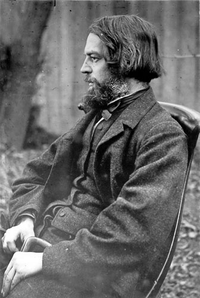
Christchurch
Christchurch is the largest city in the South Island of New Zealand, and the country's second-largest urban area after Auckland. It lies one third of the way down the South Island's east coast, just north of Banks Peninsula which itself, since 2006, lies within the formal limits of...
's unique architectural identity and culture, and was appointed the first official Provincial Architect of the developing province of Canterbury
Canterbury, New Zealand
The New Zealand region of Canterbury is mainly composed of the Canterbury Plains and the surrounding mountains. Its main city, Christchurch, hosts the main office of the Christchurch City Council, the Canterbury Regional Council - called Environment Canterbury - and the University of Canterbury.-...
. Heavily influenced by the Anglo-Catholic
Anglo-Catholicism
The terms Anglo-Catholic and Anglo-Catholicism describe people, beliefs and practices within Anglicanism that affirm the Catholic, rather than Protestant, heritage and identity of the Anglican churches....
philosophy behind early Victorian architecture, he is credited with importing the Gothic revival style to New Zealand. His Gothic designs constructed in both wood and stone in the province are considered unique to New Zealand. Today he is considered the founding architect of the province of Canterbury.
Early life
Mountfort was born in BirminghamBirmingham
Birmingham is a city and metropolitan borough in the West Midlands of England. It is the most populous British city outside the capital London, with a population of 1,036,900 , and lies at the heart of the West Midlands conurbation, the second most populous urban area in the United Kingdom with a...
, an industrial town in the Midlands
English Midlands
The Midlands, or the English Midlands, is the traditional name for the area comprising central England that broadly corresponds to the early medieval Kingdom of Mercia. It borders Southern England, Northern England, East Anglia and Wales. Its largest city is Birmingham, and it was an important...
of England, the son of perfume manufacturer and jeweller Thomas Mountfort and his wife Susanna (née Woolfield). As a young adult he moved to London, where he was an early pupil of George Gilbert Scott
George Gilbert Scott
Sir George Gilbert Scott was an English architect of the Victorian Age, chiefly associated with the design, building and renovation of churches, cathedrals and workhouses...
(from 1841–46). He also studied architecture under the Anglo-Catholic architect Richard Cromwell Carpenter
Richard Cromwell Carpenter
Richard Cromwell Carpenter was an English architect. He is chiefly remembered as an ecclesiastical and tractarian architect working in the Gothic style.-Family:...
, whose medieval Gothic
Gothic architecture
Gothic architecture is a style of architecture that flourished during the high and late medieval period. It evolved from Romanesque architecture and was succeeded by Renaissance architecture....
style of design was to have a lifelong influence on Mountfort. After completion of his training in 1848, Mountfort practised architecture in London. He married Emily Elizabeth Newman on 20 August 1850, and 18 days later the couple emigrated to New Zealand. They were some of the first settlers to the province of Canterbury, arriving on one of the famed First Four Ships, the Charlotte-Jane
Charlotte-Jane
The Charlotte Jane was one of the First Four Ships in 1850 to carry emigrants from England to the new colony of Canterbury in New Zealand.-Arrival in Lyttelton:...
on 16 December 1850. These first settlers, known as "The Pilgrims", have their names engraved on marble plaques in Cathedral Square
Cathedral Square, Christchurch
Cathedral Square, locally known simply as the Square, is the geographical centre and heart of Christchurch, New Zealand, where the city's Anglican cathedral, ChristChurch Cathedral is located...
, Christchurch, in front of the cathedral that Mountfort helped to design.
New Zealand

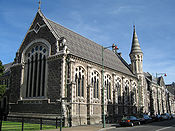
Lyttelton, New Zealand
Lyttelton is a port town on the north shore of Lyttelton Harbour close to Banks Peninsula, a suburb of Christchurch on the eastern coast of the South Island of New Zealand....
, built in 1852. The building proved vulnerable to high winds and was considered unsafe. It was demolished in 1857. This calamity was attributed to the use of unseasoned wood and his lack of knowledge of the local building materials. Whatever the cause, the result was a crushing blow to his reputation. A local newspaper called him "... a half-educated architect whose buildings... have given anything but satisfaction, he being evidently deficient in all knowledge of the principles of construction, though a clever draughtsman and a man of some taste.".
Due to this blow to his reputation, he began running a stationery shop, working as a newspaper agent, and giving drawing lessons until 1857 to supplement his architectural work. It was during this period in the architectural wilderness that he developed a lifelong interest in photography and supplemented his meagre income by taking photographic portraits of his neighbours.
Mountfort was a Freemason
Freemasonry
Freemasonry is a fraternal organisation that arose from obscure origins in the late 16th to early 17th century. Freemasonry now exists in various forms all over the world, with a membership estimated at around six million, including approximately 150,000 under the jurisdictions of the Grand Lodge...
and an early member of the Lodge of Unanimity, the main building of which he designed in 1863. The Lodge of Unanimity was the first Masonic Lodge
Masonic Lodge
This article is about the Masonic term for a membership group. For buildings named Masonic Lodge, see Masonic Lodge A Masonic Lodge, often termed a Private Lodge or Constituent Lodge, is the basic organisation of Freemasonry...
in the South Island
South Island
The South Island is the larger of the two major islands of New Zealand, the other being the more populous North Island. It is bordered to the north by Cook Strait, to the west by the Tasman Sea, to the south and east by the Pacific Ocean...
.
Return to architecture
In 1857 he returned to architecture and entered into a business partnership with his sister Susannah's new husband, Isaac LuckIsaac Luck
Isaac Luck was a New Zealand architect born in 1817 in Oxford, England. A professional builder, he arrived in Lyttelton on the Steadfast in 1851. Luck co-designed with his brother-in-law and business partner Benjamin Mountfort Canterbury Provincial Council Buildings in Christchurch between 1858...
. Mountfort's career received a fillip when he was commissioned to design the St John's Anglican church at Waikouaiti
Waikouaiti
Waikouaiti is a small town in East Otago, New Zealand, within the city limits of Dunedin. The town is close to the coast and the mouth of the Waikouaiti River....
in Otago. A small timber structure in the Gothic style, it was completed on December the 19th 1858 on land donated by the ex-whaler Johnny Jones. It is still in use as a church, the oldest such structure in southern New Zealand. Now within the boundaries of the city of Dunedin
Dunedin
Dunedin is the second-largest city in the South Island of New Zealand, and the principal city of the Otago Region. It is considered to be one of the four main urban centres of New Zealand for historic, cultural, and geographic reasons. Dunedin was the largest city by territorial land area until...
its simple pit-sawn timber interior successfully conjures a sense of spirituality.
Christchurch was under heavy development at this time, as it had just been granted city status and was the new administrative capital of the province of Canterbury. This provided Mountfort and Luck ample opportunity to practice their trade. In 1855 they produced a preliminary design for the new Canterbury Provincial Council Buildings
Canterbury Provincial Council Buildings
The Canterbury Provincial Council Buildings were the buildings of the Canterbury Provincial Council that administered the Canterbury Province from 1853 until the abolition of provincial government in 1876. The buildings are the only purpose-built provincial government buildings in New Zealand still...
in timber. The buildings were constructed from 1857–59, but in a more limited form than the original design. As the Provincial Council gained new functions with growth in the population and economy of the province, the buildings were enlarged with a North wing in stone and an iron clock tower
Victoria Clock Tower
The Victoria Clock Tower, also known as the Diamond Jubilee Clock Tower, is a heritage-registered clock tower located in Christchurch, New Zealand...
from 1859–60, and further enlarged with a stone council chamber and refreshment rooms in 1864–65. The buildings today are regarded as one of Mountfort's most important works.
From the exterior, the building appears austere, as was much of Mountfort's early work: a central tower dominates two flanking gabled wings in the Gothic revival style. However the interior was a riot of colour and medievalism as perceived through Victorian eyes; it included stained glass windows, and a large double-faced clock, thought to be one of only five around the globe. The chamber is decorated in a rich, almost Ruskinesque
John Ruskin
John Ruskin was the leading English art critic of the Victorian era, also an art patron, draughtsman, watercolourist, a prominent social thinker and philanthropist. He wrote on subjects ranging from geology to architecture, myth to ornithology, literature to education, and botany to political...
style, with carvings by a local sculptor William Brassington
William Brassington
William Brassington was a stonemason, sculptor and builder practising in Christchurch, New Zealand in the late 19th century...
. Included in the carvings are representations of indigenous New Zealand species.
Gothic architecture
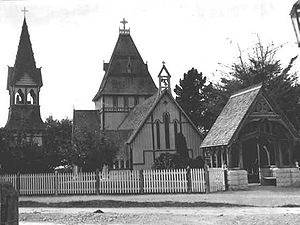
Romanticism
Romanticism was an artistic, literary and intellectual movement that originated in the second half of the 18th century in Europe, and gained strength in reaction to the Industrial Revolution...
backlash against the more classical
Classicism
Classicism, in the arts, refers generally to a high regard for classical antiquity, as setting standards for taste which the classicists seek to emulate. The art of classicism typically seeks to be formal and restrained: of the Discobolus Sir Kenneth Clark observed, "if we object to his restraint...
and formal styles which had predominated the previous two centuries. At the age of 16, Mountfort acquired two books written by the Gothic revivalist Augustus Pugin
Augustus Pugin
Augustus Welby Northmore Pugin was an English architect, designer, and theorist of design, now best remembered for his work in the Gothic Revival style, particularly churches and the Palace of Westminster. Pugin was the father of E. W...
: The True Principles of Christian or Pointed Architecture and An Apology for the Revival of Christian Architecture. From this time onwards, Mountfort was a disciple of Pugin's strong Anglo-Catholic architectural values. These values were further cemented in 1846, at the age of 21, Mountfort became a pupil of Richard Cromwell Carpenter.
Carpenter was, like Mountfort, a devout Anglo-Catholic and subscribed to the theories of Tractarianism, and thus to the Oxford
Oxford Movement
The Oxford Movement was a movement of High Church Anglicans, eventually developing into Anglo-Catholicism. The movement, whose members were often associated with the University of Oxford, argued for the reinstatement of lost Christian traditions of faith and their inclusion into Anglican liturgy...
and Cambridge Movement
Cambridge Movement
The Cambridge Movement was a conservative ideological school of thought closely related to the Oxford Movement.- History :It has been claimed the origins of the movement emanate from the teachings of the Cambridge University professor and intellectual Desiderius Erasmus...
s. These conservative theological movements taught that true spirituality and concentration in prayer was influenced by the physical surroundings, and that the medieval church had been more spiritual than that of the early 19th century. As a result of this theology, medieval architecture was declared to be of greater spiritual value than the classical Palladian
Palladian architecture
Palladian architecture is a European style of architecture derived from the designs of the Venetian architect Andrea Palladio . The term "Palladian" normally refers to buildings in a style inspired by Palladio's own work; that which is recognised as Palladian architecture today is an evolution of...
-based styles of the 18th and early 19th centuries. Augustus Pugin even pronounced that medieval architecture was the only form suitable for a church and that Palladianism was almost heretical. Such theory was not confined to architects, and continued well into the 20th century. This school of thought led intellectuals such as the English poet Ezra Pound
Ezra Pound
Ezra Weston Loomis Pound was an American expatriate poet and critic and a major figure in the early modernist movement in poetry...
to prefer Romanesque
Romanesque architecture
Romanesque architecture is an architectural style of Medieval Europe characterised by semi-circular arches. There is no consensus for the beginning date of the Romanesque architecture, with proposals ranging from the 6th to the 10th century. It developed in the 12th century into the Gothic style,...
buildings to Baroque
Baroque architecture
Baroque architecture is a term used to describe the building style of the Baroque era, begun in late sixteenth century Italy, that took the Roman vocabulary of Renaissance architecture and used it in a new rhetorical and theatrical fashion, often to express the triumph of the Catholic Church and...
on the grounds that the latter represented an abandonment of the world of intellectual clarity and light for a set of values that centred around hell and the increasing dominance of society by bankers, a breed to be despised.
Whatever the philosophy behind the Gothic revival, in London the 19th-century rulers of the British Empire felt that Gothic architecture was suitable for the colonies because of its then strong Anglican connotations, representing hard work, morality and conversion of native peoples. The irony of this was that many of Mountfort's churches were for Roman Catholics, as so many of the new immigrants were of Irish origin. To the many middle-class English empire builders, Gothic represented a nostalgic reminder of the parishes left behind in Britain with their true medieval architecture; these were the patrons who chose the architects and designs.
Mountfort's early Gothic work in New Zealand was of the more severe Anglican variety as practised by Carpenter, with tall lancet window
Lancet window
A lancet window is a tall narrow window with a pointed arch at its top. It acquired the "lancet" name from its resemblance to a lance. Instances of this architectural motif are most often found in Gothic and ecclesiastical structures, where they are often placed singly or in pairs.The motif first...
s and many gable
Gable
A gable is the generally triangular portion of a wall between the edges of a sloping roof. The shape of the gable and how it is detailed depends on the structural system being used and aesthetic concerns. Thus the type of roof enclosing the volume dictates the shape of the gable...
s. As his career progressed, and he had proved himself to the employing authorities, his designs developed into a more European form, with towers, turrets and high ornamental roof lines in the French manner, a style which was in no way peculiar to Mountfort but was endorsed by such architects as Alfred Waterhouse
Alfred Waterhouse
Alfred Waterhouse was a British architect, particularly associated with the Victorian Gothic Revival architecture. He is perhaps best known for his design for the Natural History Museum in London, and Manchester Town Hall, although he also built a wide variety of other buildings throughout the...
in Britain.
Mountfort's skill as an architect lay in adapting these flamboyant styles to suit the limited materials available in New Zealand. While wooden churches are plentiful in certain parts of the USA, they are generally of a simple classic design, whereas Mountfort's wooden churches in New Zealand are as much ornate Gothic fantasies as those he designed in stone. Perhaps the flamboyance of his work can be explained in a statement of principles he and his partner Luck wrote when bidding to win the commission to design Government House, Auckland in 1857:
Provincial Architect
.jpg)
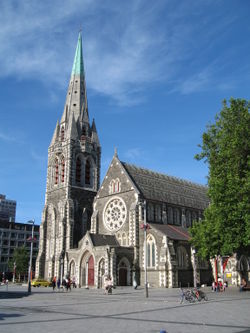
Francis Petre
Francis William "Frank" Petre was a prominent New Zealand-born architect based in Dunedin. He was an able exponent of the Gothic revival style, one of its best practitioners in New Zealand. He followed the Roman Church's initiative to build Catholic places of worship in Anglo-Saxon countries in...
, though the cenotaph
Cenotaph
A cenotaph is an "empty tomb" or a monument erected in honour of a person or group of people whose remains are elsewhere. It can also be the initial tomb for a person who has since been interred elsewhere. The word derives from the Greek κενοτάφιον = kenotaphion...
by Mountfort was preserved. Mountfort often worked in wood, a material he in no way regarded as an impediment to the Gothic style, though he was unique in this respect as Gothic buildings were often created from stone and mortar. Between 1869 and 1882 he designed the Canterbury Museum and subsequently Canterbury College
University of Canterbury
The University of Canterbury , New Zealand's second-oldest university, operates its main campus in the suburb of Ilam in the city of Christchurch, New Zealand...
and its clock tower in 1877.
Construction on the buildings for the Canterbury College, which later became the University of Canterbury
University of Canterbury
The University of Canterbury , New Zealand's second-oldest university, operates its main campus in the suburb of Ilam in the city of Christchurch, New Zealand...
, began with the construction of the clock tower block. This edifice, which opened in 1877, was the first purpose built university in New Zealand. The College was completed in two subsequent stages in Mountfort's usual Gothic style.
George Gilbert Scott
George Gilbert Scott
Sir George Gilbert Scott was an English architect of the Victorian Age, chiefly associated with the design, building and renovation of churches, cathedrals and workhouses...
, the architect of ChristChurch Cathedral, and an empathiser of Mountfort's teacher and mentor Carpenter, wished his former pupil Mountfort to be the clerk of works
Clerk of Works
Clerks of Works are the most highly qualified non-commissioned tradesmen in the Royal Engineers. The qualification can be held in three specialisations: Electrical, Mechanical and Construction. The clerk of works , often abbreviated CoW, is employed by the architect or client on a construction site...
and supervising architect of the new cathedral project. This proposal was originally vetoed by the Cathedral Commission. Nevertheless, following delays in the building work attributed to financial problems, the position of supervising architect was finally given to Mountfort in 1873. Mountfort was responsible for several alterations to the absentee main architect's design, most obviously the tower and the west porch
Porch
A porch is external to the walls of the main building proper, but may be enclosed by screen, latticework, broad windows, or other light frame walls extending from the main structure.There are various styles of porches, all of which depend on the architectural tradition of its location...
. He also designed the font
Baptismal font
A baptismal font is an article of church furniture or a fixture used for the baptism of children and adults.-Aspersion and affusion fonts:...
, the Harper Memorial, and the north porch. The cathedral was however not finally completed until 1904, six years after Mountfort's death. The cathedral is very much in the European decorated Gothic style with an attached campanile
Campanile
Campanile is an Italian word meaning "bell tower" . The term applies to bell towers which are either part of a larger building or free-standing, although in American English, the latter meaning has become prevalent.The most famous campanile is probably the Leaning Tower of Pisa...
tower beside the body of the cathedral, rather than towering directly above it in the more English tradition.
In 1872 Mountfort became a founding member of the Canterbury Association of Architects, a body which was responsible for all subsequent development of the new city. Mountfort was now at the pinnacle of his career. Mountfort notably altered the use of a segmented arch rather than one in the Romanesque style; the latter of which was considered by Augustus Pugin to be fundamentally important to the Gothic style. The college posed a challenge in its main hall; on the hall's completion in 1882, it was the largest public space in Christchurch. Additionally, a level of detail not possible in previous works was present in the hall's design due to the superior funding for the college. The completion of the first stage was met with praise and optimism, though extensions such as a biological lab were added in the early 1890s. By the 1880s, Mountfort was hailed as New Zealand's premier ecclesiastical architect, with over forty churches to his credit.
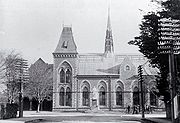
Napier, New Zealand
Napier is a New Zealand city with a seaport, located in Hawke's Bay on the eastern coast of the North Island. The population of Napier is about About 18 kilometres south of Napier is the inland city of Hastings. These two neighboring cities are often called "The Twin Cities" or "The Bay Cities"...
. This brick construction was demolished in the disastrous 1931 earthquake that destroyed much of Napier. Between 1886 and 1897, Mountfort worked on one of his largest churches, the wooden St Mary's, the cathedral church of Auckland
Auckland
The Auckland metropolitan area , in the North Island of New Zealand, is the largest and most populous urban area in the country with residents, percent of the country's population. Auckland also has the largest Polynesian population of any city in the world...
. Covering 9000 square feet (836.1 m²), St Mary's is the largest and last timber church built by Mountfort, and the largest wooden Gothic church in the world. At its completion, it was said that "in point of design, completeness and beauty [it] reaches a high level mark not yet approached in the diocese". The emphasis placed on the sweeping roof by the great aisle windows struck a balance to the great area the church enclosed. In 1982 the entire church, complete with its stained glass windows, was transported to a new site, across the road from its former position where a new cathedral was to be built. St Mary's church was consecrated in 1898, one of Mountfort's final grand works.
Outside of his career, Mountfort was keenly interested in the arts and a talented artist, although his artistic work appears to have been confined to art pertaining to architecture, his first love. He was a devout member of the Church of England
Church of England
The Church of England is the officially established Christian church in England and the Mother Church of the worldwide Anglican Communion. The church considers itself within the tradition of Western Christianity and dates its formal establishment principally to the mission to England by St...
and a member of many Anglican church councils and diocese
Diocese
A diocese is the district or see under the supervision of a bishop. It is divided into parishes.An archdiocese is more significant than a diocese. An archdiocese is presided over by an archbishop whose see may have or had importance due to size or historical significance...
committees.
Mountfort's later years were blighted by professional jealousies, as his position as the province's first architect was assailed by new and younger men influenced by new orders of architecture. Benjamin Mountfort died in 1898, aged 73. He was buried in the cemetery of Holy Trinity Avonside
Holy Trinity Avonside
Holy Trinity Avonside was a heritage-listed Anglican church located in Linwood, Christchurch, New Zealand. It is registered as a "Historic Place – Category I" by the New Zealand Historic Places Trust...
, the church which he had extended in 1876.
Legacy
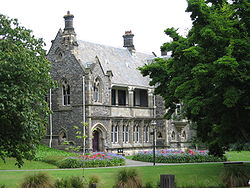

Cyril Mountfort
Cyril Julian Mountfort was a New Zealand ecclesiastical architect. He was educated at Christ's College and then studied architecture under his father, the prominent New Zealand architect, Benjamin Mountfort....
, continued to work in his father's Gothic style well into the 20th century. Cyril Mountfort was responsible for the church of "St. Luke's in the City" which was an unexecuted design of his father's. In this way, and through the daily public use of his many buildings, Mountfort's legacy lives on. He ranks today with his contemporary R A Lawson
Robert Lawson (architect)
Robert Arthur Lawson was one of New Zealand's pre-eminent 19th century architects. It has been said he did more than any other designer to shape the face of the Victorian era architecture of the city of Dunedin...
as one of New Zealand's greatest 19th century architects.
Selected buildings
- Most Holy Trinity in Lyttelton, 1852 (demolished, 1857)
- Canterbury Provincial Council Buildings, 1858–1865 (partially collapsed in the 2011 Canterbury earthquake)
- Christchurch Cathedral, begun 1864 (replaced with new building, 1901; partially collapsed in the 2011 Canterbury earthquake)
- Canterbury Museum, 1869–1882
- St. Augustine's Church, Waimate 1872 (photo)
- Trinity Church, Christchurch 1872 (partially collapsed in the 2011 Canterbury earthquake)
- Holy Trinity AvonsideHoly Trinity AvonsideHoly Trinity Avonside was a heritage-listed Anglican church located in Linwood, Christchurch, New Zealand. It is registered as a "Historic Place – Category I" by the New Zealand Historic Places Trust...
Church Chancel, 1874–1877 (photo) - St Paul's Church, PapanuiPapanuiPapanui is a major suburb of Christchurch New Zealand. It is sited five kilometers to the northwest of the city centre. Papanui is a middle socio-economic area with a population of 3,543 consisting predominantly of Pākehā 92.3%, Māori 5.7%, Pacific peoples 2.5%, Asian 5.0%, Middle Eastern/Latin...
, 1876–1877 - Canterbury College Hall, Christchurch, 1882 (photo)
- Church of the Good ShepherdChurch of the Good Shepherd, ChristchurchThe Church of the Good Shepherd in Phillipstown, Christchurch, New Zealand is the oldest and only surviving brick church designed by architect Benjamin Mountfort...
, PhillipstownPhillipstown, New ZealandPhillipstown is a small inner suburb of the city of Christchurch, New Zealand. It lies south-east of the city centre being bordered by Tuam Street to the north, Olliviers Road to the east, the Lyttelton rail line to the south, and Fitzgerald Avenue to the west....
, 1884–1885 - St Mary's Church, Auckland, begun 1886 (relocated, 1982)
- St John's Cathedral, NapierNapier, New ZealandNapier is a New Zealand city with a seaport, located in Hawke's Bay on the eastern coast of the North Island. The population of Napier is about About 18 kilometres south of Napier is the inland city of Hastings. These two neighboring cities are often called "The Twin Cities" or "The Bay Cities"...
, 1886–1888 - Sunnyside Asylum, Christchurch, 1881–1893

